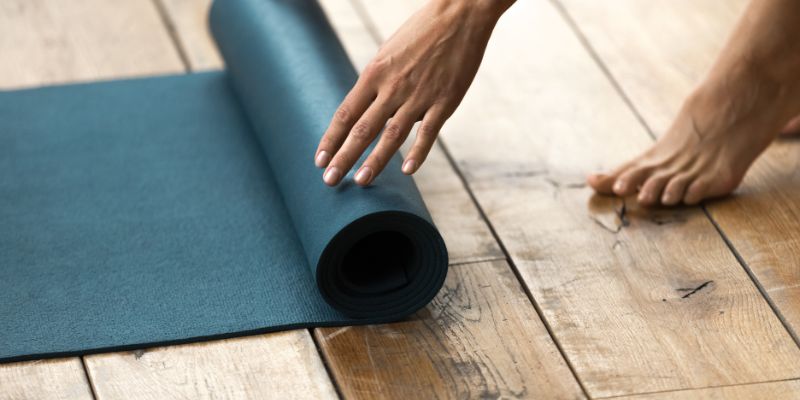Exploring Health Advantages of Anaerobic Pilates Exercise
Nov 08, 2023 By Nancy Miller
Anaerobic exercise, which occurs in the absence of oxygen, is designed to build muscle. Such exercise is distinct from its aerobic equivalent in that it calls for greater intensity over a shorter time period.
Stamina is increased, fat is burned, and bone density is increased thanks to anaerobic exercise. The following sections will discuss these advantages, provide examples of many types of anaerobic exercises, and offer suggestions on how to incorporate them into your regular routine.

What Constitutes Anaerobic Exercise?
Anaerobic exercise is any kind of physical activity that does not need oxygen. Aerobic exercise, on the other hand, uses oxygen to generate energy. Anaerobic activities need quick, strong muscle contractions that surpass the pace at which oxygen supplies energy. Glycogen, a form of glucose that can be stored, is what the muscles turn to when they need energy fast.
Underlying Mechanisms of Anaerobic Activity
When oxygen is not present, glycogen in muscle cells is broken down into glucose. These components undergo a biphasic change called lactic acid fermentation, which provides energy for skeletal muscle contractions.
During the first stage, called glycolysis, glucose is broken down into pyruvic acid, which may then be used to create ATP. The well-known muscle burn results from the subsequent conversion of pyruvic acid to lactic acid.
These kinds of workouts need frequent breaks to prevent fatigue and pain from lactic acid accumulation.
Anaerobic Activity Examples
- Most anaerobic activities are short bursts of high intensity. Numerous examples include:
- Exercise with weights
- High-intensity interval training (HIIT) with sprints: Intervals of intense work followed by short recovery
- Plyometrics are explosive exercises that include jumping and hopping.
- Bodyweight training (or callisthenics) consists of exercises such as push-ups and pull-ups.
Pilates Anaerobic Benefits
Expenditure of Lipids During and Post-Exertion
The ratio of glucose, glycogen, and lipids used for energy during exercise varies in response to the intensity of the activity.
Low-intensity efforts often rely on lipids. Increasing the intensity of the exertion causes a greater release of glycogen or glucose, although fat is still burned, particularly after an anaerobic exercise. Take a small research that contrasted steady-state and high-intensity interval training in young males. Although steady-state exercise used more energy during the session, high-intensity interval training increased energy expenditure and lipid utilization afterwards.
Enhance Muscular Volume
Strength in both the heart and the muscles is improved by anaerobic exercise. A study with top young handball players indicated that sprint intervals significantly increased muscle-building hormones.

Maximize Oxygen Utilization
Those strenuous burpee sets have advantages beyond transient breathlessness. Anaerobic exercise increases your maximum oxygen consumption (VO2 max). Anaerobic activities improve your aerobic and anaerobic systems even if they don't include oxygen, as shown by studies.
Elevate Metabolic Rate
To speed up fat burning, combine aerobic and anaerobic training. One study found that obese participants who did both aerobic and anaerobic exercise had a significant decrease in lipid mass. At the same time, weight training and other forms of anaerobic exercise may increase your resting metabolic rate and, hence, your calorie expenditure even while at rest without affecting blood sugar or insulin levels.
A separate study looked at the effects of varying the intensity of resistance workouts on those with high fasting blood glucose. Those engaged in high-intensity exercises revealed greater insulin sensitivity and a drop in fasting glucose.
Waist Reduction
Scientific evidence shows that those who regularly engage in HIIT have a significant reduction in their waist-to-hip ratio. Additional reviews have shown that high-intensity intermittent training is superior to continuous aerobic exercise in reducing abdominal fat. This is because of the increased lipid oxidation that occurs during and after training, the decreased insulin levels that result, and the increased muscle fatty acid oxidation capacity.
Mitigate Muscle Atrophy with Age
With age comes the inevitable loss of muscle mass. Reduce the loss of muscle mass by doing resistance workouts like planks and squats and eating foods high in protein.
Age-related muscle loss, known as sarcopenia, perpetuates itself in a vicious cycle. Exercise becomes more difficult when muscles atrophy. Because of the pain, you may put off getting moving, but simple tasks might quickly become challenging. Any increase in exercise, even a little activity like walking, may have positive effects on health.
Foster Osteal Fortitude
Building muscle has been shown to protect against bone loss caused by osteoporosis. Anaerobic exercise routines, such as sprinting, are particularly effective in preventing muscle and bone breakdown over time. Bone density may be increased by walking alone, but studies show that a combination of aerobic and anaerobic activity is much more beneficial. Particularly effective for boosting bone mineral density is gradual resistance exercise.
Augment Joint Functionality
By keeping sturdy joints, anaerobic exercise increases mobility. These exercises strengthen the muscles and connective tissues, making the body less prone to injuries. The femur joint benefits greatly from a combination of aerobic and anaerobic workouts.
Minimize Fall Incidence
Anaerobic workouts, which focus on strengthening the core muscles, may greatly enhance balance and reduce fall risks. Stronger muscles and bones may better absorb force upon contact, decreasing the likelihood of injury from falls. Think of anaerobic exercise as insurance against losing independence as you get older.
Alleviate DOMS Potential
The possibility of delayed onset muscle soreness (DOMS) can prevent individuals from undertaking strength training or high-intensity interval training (HIIT). Acclimatization is necessary for anaerobic exercise. Consistent anaerobic exercise leads to repeated effects, wherein your muscles become more resistant to DOMS.
Increases in muscle mass are associated with enhanced resistance to the stressors of exercise and a more rapid recovery time thereafter.
Elevate Cerebral Function
Interval exercise may also be beneficial for cognitive function. Research comparing interval training to steady-state exercise found that although both types of exercise increased cerebral blood flow, the cumulative change in blood velocity inside the cerebral arteries was larger after interval training.
Brain blood flow is improved by both continuous and occasional bursts of intense activity.
Amplify Life Quality
Anaerobic exercise stands out as a significant improvement in well-being in light of the aforementioned advantages. It lessens the chance of chronic illnesses while easing daily duties and exercises, improving attractiveness, elevating mood, sharpening the intellect, and smoothing the ageing process.
Recommended Quantities of Anaerobic Pilates Exercises
You can do the following exercises:
- Moderate exercise for 150 minutes
- Intense physical activity for 75 minutes
- Including both light and strenuous pursuits
Exercising at a high intensity includes activities like weightlifting, sprinting, and other anaerobic workouts. Strength training (anaerobic) and cardio (aerobic), such as walking or swimming, should be combined for optimal fitness.
Conclusion
A wide range of health advantages, from enhanced muscle and bone strength to enhanced joint function and brain blood flow, make anaerobic exercise a remarkable instrument for health improvement. Its benefits in slowing down physical deterioration associated with ageing and improving quality of life are undeniable. Regular anaerobic exercise has been shown to provide several health advantages, including increased physical strength, decreased risk of falls, reduced muscular pain, and even improved mental clarity.








